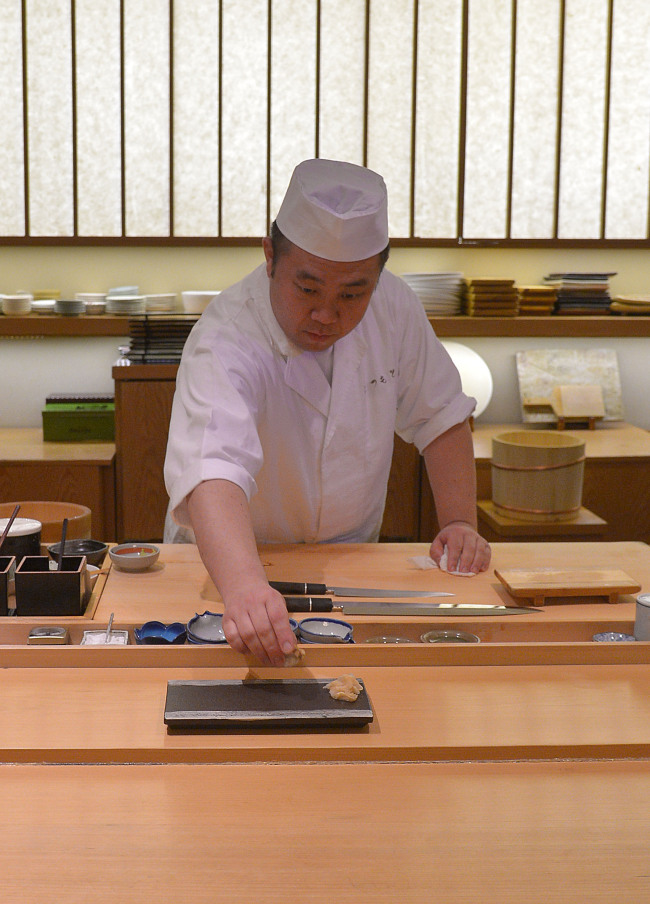Classic, no-fuss sushi at Matsumoto
Sushi-ya spares the frills and focuses on tradition
By 이우영Published : April 1, 2016 - 17:30
Hours later, after the last piece has been consumed, it is the memory of the rice served at Sushi Matsumoto that lingers, how each oblong orb under its blanket of fish was consistently warm, pillowy and subtly seasoned.
“With sushi, one should not only focus on the fish, the rice needs to be good as well,” head chef Matsumoto Mizuho explains.

Good rice is not a general concept for Matsumoto.
For the veteran sushi chef, who honed his skills at Japan’s famed sushi-ya Kyubey before coming to Korea, good sushi rice, called “shari” in Japanese, begins with a finite idea -- which fish does one intend to pair this rice with?
Matsumoto considers tuna to be his sushi-ya’s ace and so the “shari” is seasoned to suit tuna.
“We do not put any sugar in our rice, only vinegar and salt, so when the rice is warm you can taste a natural sweetness, a sweetness that is harder to taste when the rice cools down,” Matsumoto, 41, elaborated.
For that reason the shari is always kept warm.
Temperature and seasoning, however, are only part of the whole sushi rice equation. How it is shaped also matters, which means an orb where the kernels “barely stick together” for Matsumoto.
“That is why one should eat sushi with one’s fingers, so it does not fall apart,” he instructed.
Per Matsumoto’s instructions, picking up one’s sushi by holding it lightly between one’s fingers definitely prevents any lost kernels of rice or breakage, for one whole, intact mouthful.

At Matsumoto, the quality is consistent, ranging from soft, sweet and thick morsels of tuna and gleaming silver-skinned herring topped with a blend of chopped ginger and green onion.
There are delicate nori-wrapped rolls like Matsumoto’s negi toro, where finely chopped tuna is layered over rice and topped with the white part of green onions.
There is salt-water eel, called “anago,” which is served up as two pieces, one seasoned with a soy sauce-base and the other with salt and yuzu.
Anago, for Matsumoto, seems to hold its own place of significance.
“When I first went to Kyubey, I tasted their anago sushi,” he recalled. “It was seasoned with salt and yuzu and was fragrant. When I ate it, it was crispy at first and then soft when the fish mingled with the rice.”
“I make the anago sushi here with that memory in mind,” he said.
In essence, as with any chef, the food presented at Matsumoto is partly the result of years of accumulated experiences and memories, which in Matsumoto’s case includes Kyubey and Westin Chosun Seoul’s Sushi Cho.
In 2011, he became head chef of Sushi Matsumoto, where, for over four years, he and his team have been serving sushi from their quiet perch in Sinsa-dong.
At the small counter, nine seats in total, one can simply sit back and enjoy a parade of sushi, interrupted by several small dishes of clam in fragrant yuzu broth or soy sauce-seasoned octopus until that telling moment, when a final piece of sweet omelet, tamago, is served.
“Sushi-ya do not generally serve dessert, so that is why tamago is served at the end,” Sushi Matsumoto sous chef Min Jong-woo, 30, explained the tradition of signaling that the last piece of sushi has been served with a thick block of sweet omelet.
After that square of cake-like tamago has been served, one can choose dessert, either a scoop of ice cream or a sweet treat of monaka, a sticky rice wafer, filled with red bean paste and green tea ice cream.
Yet it is not the dessert that Matsumoto hopes one will remember; it is the sushi.
Sushi Matsumoto
630-1 Sinsa-dong, Gangnam-gu, Seoul
(02) 543-4334
Open noon to 2:30 p.m., 6 p.m. to 10 p.m. daily
Reservations for counter or room seating required
Lunch costs 55,000 won t0 165,000 won, dinner costs 165,000 won to 220,000 won
By Jean Oh (oh_jean@heraldcorp.com)
















![[KH Explains] Hyundai's full hybrid edge to pay off amid slow transition to pure EVs](http://res.heraldm.com/phpwas/restmb_idxmake.php?idx=652&simg=/content/image/2024/04/18/20240418050645_0.jpg&u=20240418181020)

![[Today’s K-pop] Zico drops snippet of collaboration with Jennie](http://res.heraldm.com/phpwas/restmb_idxmake.php?idx=642&simg=/content/image/2024/04/18/20240418050702_0.jpg&u=)